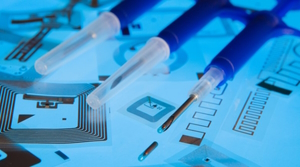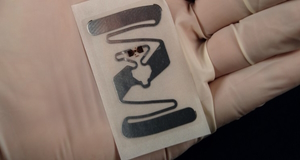At Metalcraft, we specialize in providing complete RFID solutions to our customers. Because we offer a wide variety of RFID solutions, our customers may not be aware of all of Metalcraft's capabilities. Did you know that Metalcraft's newest brand, Inlay Innovation, designs, develops and manufactures custom RFID inlays? Since we can design everything but the chip in-house, we can make inlays that are tailored to suit your needs. In order to make custom inlays, there are several steps that our teams in Mason City and Ames go through.

Creating a Concept
After qualifying the opportunity with the customer, the Metalcraft team in Mason City gets to work on meeting the customer's specifications. These include read range requirements, memory and ensuring the chip works in particular climate conditions. Hours of design work go into creating antennas that best match the customer's desired impedance, size and styling using AutoCAD software. Once they've been designed, the inlay drawings are used to manufacture samples. These samples are then used to begin the inlay hand craftsmanship process.
Crafting the Inlay
Once the antennas are in Ames, lab equipment and the Muhlbauer TTS300 are set up. This equipment is used for the chip to antenna bonding process. Antennas are cut out and placed underneath the view of a microscope. Once it's been cut, a tool called the Delomat 101 is used to place a precise amount of bonding epoxy to the landing pad of the antenna. The die is then placed by hand onto the dot of epoxy and it's lined up with the landing pad to match the die orientation with the antenna. After that, the die is placed by hand onto the dot of epoxy and lined up with the landing pad to match the die orientation with the antenna.
out and placed underneath the view of a microscope. Once it's been cut, a tool called the Delomat 101 is used to place a precise amount of bonding epoxy to the landing pad of the antenna. The die is then placed by hand onto the dot of epoxy and it's lined up with the landing pad to match the die orientation with the antenna. After that, the die is placed by hand onto the dot of epoxy and lined up with the landing pad to match the die orientation with the antenna.
The next step in the process involves bringing the unbonded inlay to the TTS300 for it to be bonded. This bonding process requires an exact pressure, temperature and time setting so that the chip bonds correctly and is not destroyed. After the inlay is completed, a read test is done to find out if the inlay is active. Completed inlays are then packaged and labeled in antistatic baggies and sent back to Mason City for further testing.
The Final Testing Stage
Metalcraft's team in Mason City tests the completed inlays in our Voyantic chamber to understand what readings they are getting out of the inlays. This testing procedure is to ensure that the antenna design matches the expected requirements consistently throughout the set of inlays. If the inlays meet expectations, they are either sent out to customers for live testing or they are manufactured in larger quantities. If the testing does not meet specifications, the design is adjusted and the process is repeated.
to ensure that the antenna design matches the expected requirements consistently throughout the set of inlays. If the inlays meet expectations, they are either sent out to customers for live testing or they are manufactured in larger quantities. If the testing does not meet specifications, the design is adjusted and the process is repeated.
If you would like to learn more about RFIDs with custom inlays, contact us at [email protected].
 | About the Author: Colby Weber Colby is Metalcraft's Marketing Assistant. He enjoys being able to combine his marketing and public relations skills with his writing and graphic design abilities to assist in Metalcraft's marketing efforts. He has one brother, a niece and two nephews. In his free time, Colby enjoys playing video games and trading card games. He's also a fan of anime and creating digital artwork on his drawing tablet. |




